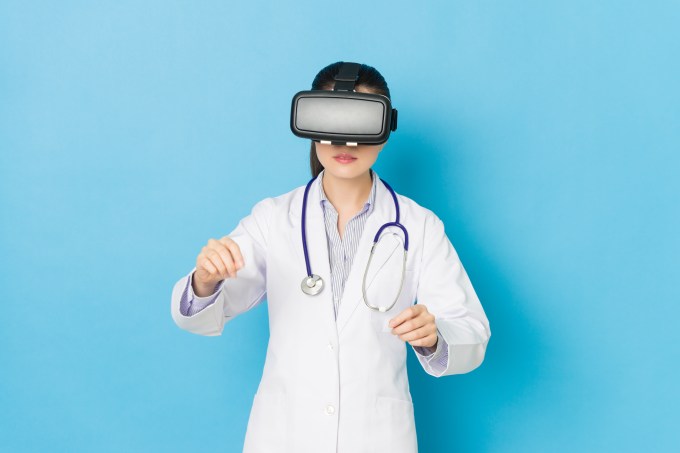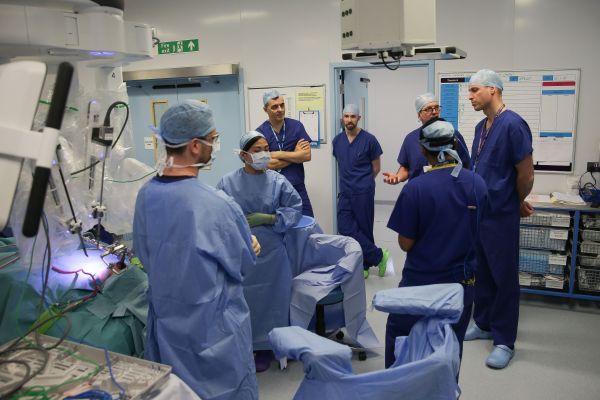About 20 years ago, a medical device startup called Intuitive Surgical debuted the da Vinci robot and changed surgical practices in operating rooms across the United States.
The da Vinci ushered in the first age of robotic-assisted surgical procedures with a promise of greater accuracy and quicker recovery times for patients undergoing certain laparoscopic surgeries.
For a time, it was largely alone in the market. It has skyrocketed in value since 2000, when the stock first debuted on public markets. From the $46 million that the company initially raised in its public offering to now, with a market capitalization of nearly $63 billion, Intuitive has been at the forefront of robotic-assisted surgeries, but now a new crop of startups is emerging to challenge the company’s dominance.
Backed by hundreds of millions in venture capital dollars, new businesses are coming to refashion operating rooms again — this time using new visualization and display technologies like virtual and augmented reality, and a new class of operating robots. Their vision is to drive down the cost and improve the quality of surgical procedures through automation and robotic equipment.
“There were 900,000 surgeries done using surgical robotics out of a total of 313 million surgical procedures,” globally, says Dror Berman, a managing director of Innovation Endeavors.
Berman is an investor in Vicarious Surgical, a new robotics company that plans to not only improve the cost and efficiency of surgical procedures, but enable them to be performed remotely so the best surgeons can be found to perform operations no matter where in the world they are.
“Robotics and automation present multiple opportunities to improve current processes, from providing scientists the opportunity to vastly increase experimental throughput, to allowing people with disabilities to regain use of their limbs,” Berman wrote in a blog post announcing his firm’s initial investment in Vicarious.
The $3.4 billion acquisition of Auris Health by Johnson & Johnson shows just how lucrative the market for new surgical robotics can be.
That company, founded by one of the progenitors of the surgical robotics industry, Fred Moll, is the first to offer serious competition to Intuitive Surgical’s technological advantage — no wonder, considering Dr. Moll also founded Intuitive Surgical.
Last year, the company unveiled its Monarch platform, which takes an endoscopic approach to surgical procedures that is less invasive and more accurate to test for — and treat — lung cancer.
“A CT scan shows a mass or a lesion,” Dr. Moll said in an interview at the time. “It doesn’t tell you what it is. Then you have to get a piece of lung, and if it’s a small lesion. It isn’t that easy — it can be quite a traumatic procedure. So you’d like to do it in a very systematic and minimally invasive fashion. Currently it’s difficult with manual techniques and 40 percent of the time, there is no diagnosis. This is has been a problem for many years and [inhibits] the ability of a clinician to diagnose and treat early-stage cancer.”
Monarch uses an endoscopy procedure to insert a flexible robot into hard-to-reach places inside the human body. Doctors trained on the system use video game-style controllers to navigate inside, with help from 3D models.
Meanwhile, publicly traded companies like Mazor Robotics and Zimmer Biomet have robotic offerings in brain and spinal surgery. And other robotics initiatives are underway at J&J through work with Verb, the partnership it has with Verily, a subsidiary of Google’s parent company, Alphabet, and through its acquisition of Orthotaxy, a robotics company focused on knee surgeries.
It’s no wonder that medical robotics is garnering so much attention from companies big and small, given the size of the market. An analysis by the consulting firm MarketsandMarkets projects that the industry will hit $16.74 billion by 2023, up from an estimated $6.46 billion in 2018.
That analysis indicated four key segments within the robotics industry. In addition to surgical robotics, the analysts expect to see growth among rehabilitation-focused robotics, noninvasive radiosurgery robotic systems and hospital and pharmacy robotic systems. The report further breaks down rehabilitation robots among therapeutic robotics, assistive robotics, exoskeletal robotics systems and other types of rehabilitation robots.
In each category, there’s at least one startup (and one well-established device manufacturer) that has a new technology it’s looking to bring to market. TWIICE and Samsung are both competing for rehabilitation customers; while Medrobotics, Corindus and CMR Surgical have raised nearly $400 million between them from investors to address different aspects of diagnostics and surgery.
The rise of AR/VR in the operating room

PRImageFactory via Getty Images
If robots are playing a role in the operating room and in rehabilitation, then augmented reality and virtual reality are also finding their way into the healthcare market through visualization and training tools.
That includes companies like Medivis, which recently closed on $2.3 million in financing led by Initialized Capital, and inked partnerships with Dell and Microsoft to supply hardware for the company’s first product, called SurgicalAR.
It was the launch of the HoloLens that really gave Medivis its boost, according to Christopher Morley, founder of the company. That technology pointed a way toward what Morley said was one of the dreams for technology in the medical industry.
“The Holy Grail is to be able to holographically render a patient,” he said.
For now, Medivis is able to access patient data and represent it visually in a three-dimensional model for doctors to refer to as they plan surgeries. That model is mapped back to the patient to give surgeons a plan for how best to approach an operation.
As Medivis focuses on the operating room, companies like the London-based Touch Surgery are training surgeons on difficult medical procedures — creating more than 200 training programs for surgical procedures to be completed on a mobile phone or tablet. At CES in 2017, it announced support for a new type of deeply immersive surgery training — and potentially assistance in an operating room — on DAQRI and HoloLens.
These technologies are also about improving patient outcomes, according to Dr. Sarah Murthi and her colleague Amitabh Varshney, from the University of Maryland. As they write in the Harvard Business Review:
AR’s potential ability to concurrently display imaging data and other patient information could save lives and decrease medical errors. This is especially true for procedures done outside an operating room. The OR may be the safest place in the hospital, where one patient has an entire team of 4 to 8 dedicated doctors and nurses. Because everyone has pre-operative imaging, the procedures are generally well-planned. Anesthesiologists monitor the patient’s physiology and administer pain-controlling and life-saving medications. Surgical nurses make sure all of the necessary equipment is immediately available. Surgeons can be completely immersed in the operative task. But time in the room is extremely costly, and ORs are solidly booked with elective cases. Elective operations are an essential source of revenue for all hospitals, so there is incredible pressure to keep ORs full and flowing. Small, emergent procedures do not easily fit into this reality. As a result, many of these procedures are done outside the OR in intensive care units and emergency departments. It’s during these “bedside procedures” that patients may be most at risk and where AR could provide some of the greatest benefit.
Applications for virtual and augmented reality headsets extend far beyond the operating room theater. Vicarious uses both virtual reality and robotics to make remote surgery a possibility, but other startups have found even more traction by applying virtual reality to training and actual treatment of certain conditions. Take companies like OssoVR, zSpace or Medical Realities, which are using virtual reality as a surgical and medical training tool — or companies like Limbix, Psious, Oxford VR and Vivid Vision, which are using virtual reality to treat everything from anxiety and other psychological disorders to ocular disorders like lazy eye and crossed eyes.
Despite the progress, virtual reality in healthcare still has a long way to go before it can live up to the expectations that industry observers had set for it in the early days when the technology was still developing.
As Alex Senson, a healthcare professional, laid out in TechCrunch three years ago:
Overall, virtual reality in healthcare is still in its early days in terms of breakthrough treatment paradigms and widespread clinical adoption and use. Innovators in this field will be increasingly scrutinized regarding evidence for clinical efficacy through properly designed and controlled human trials. In the (not too distant) future, things will get really interesting with the seamless integration and intersection of technologies like VR with artificial intelligence, deep learning, big data analytics, sensors, bio-feedback and increased computing power.
Smart, adaptive virtual simulations that learn as a patient interacts with it will revolutionize decentralized patient-focused care and fundamentally change the way healthcare is delivered.
